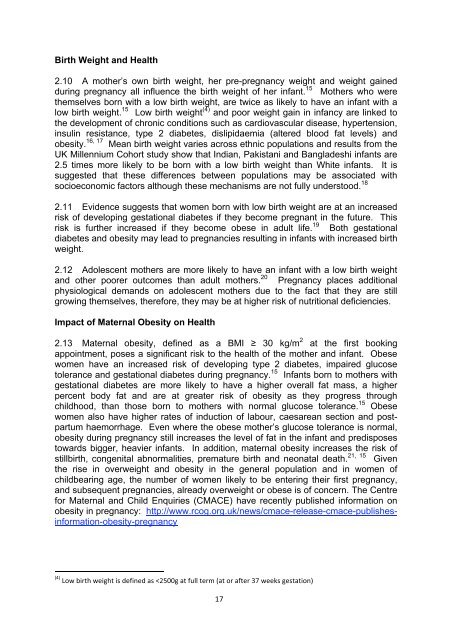Improving Maternal and Infant Nutrition: A Framework for Action
Improving Maternal and Infant Nutrition: A Framework for Action
Improving Maternal and Infant Nutrition: A Framework for Action
You also want an ePaper? Increase the reach of your titles
YUMPU automatically turns print PDFs into web optimized ePapers that Google loves.
Birth Weight <strong>and</strong> Health2.10 A mother’s own birth weight, her pre-pregnancy weight <strong>and</strong> weight gainedduring pregnancy all influence the birth weight of her infant. 15 Mothers who werethemselves born with a low birth weight, are twice as likely to have an infant with alow birth weight. 15 Low birth weight (4) <strong>and</strong> poor weight gain in infancy are linked tothe development of chronic conditions such as cardiovascular disease, hypertension,insulin resistance, type 2 diabetes, dislipidaemia (altered blood fat levels) <strong>and</strong>16, 17obesity. Mean birth weight varies across ethnic populations <strong>and</strong> results from theUK Millennium Cohort study show that Indian, Pakistani <strong>and</strong> Bangladeshi infants are2.5 times more likely to be born with a low birth weight than White infants. It issuggested that these differences between populations may be associated withsocioeconomic factors although these mechanisms are not fully understood. 182.11 Evidence suggests that women born with low birth weight are at an increasedrisk of developing gestational diabetes if they become pregnant in the future. Thisrisk is further increased if they become obese in adult life. 19 Both gestationaldiabetes <strong>and</strong> obesity may lead to pregnancies resulting in infants with increased birthweight.2.12 Adolescent mothers are more likely to have an infant with a low birth weight<strong>and</strong> other poorer outcomes than adult mothers. 20 Pregnancy places additionalphysiological dem<strong>and</strong>s on adolescent mothers due to the fact that they are stillgrowing themselves, there<strong>for</strong>e, they may be at higher risk of nutritional deficiencies.Impact of <strong>Maternal</strong> Obesity on Health2.13 <strong>Maternal</strong> obesity, defined as a BMI 30 kg/m 2 at the first bookingappointment, poses a significant risk to the health of the mother <strong>and</strong> infant. Obesewomen have an increased risk of developing type 2 diabetes, impaired glucosetolerance <strong>and</strong> gestational diabetes during pregnancy. 15 <strong>Infant</strong>s born to mothers withgestational diabetes are more likely to have a higher overall fat mass, a higherpercent body fat <strong>and</strong> are at greater risk of obesity as they progress throughchildhood, than those born to mothers with normal glucose tolerance. 15 Obesewomen also have higher rates of induction of labour, caesarean section <strong>and</strong> postpartumhaemorrhage. Even where the obese mother’s glucose tolerance is normal,obesity during pregnancy still increases the level of fat in the infant <strong>and</strong> predisposestowards bigger, heavier infants. In addition, maternal obesity increases the risk of21, 15stillbirth, congenital abnormalities, premature birth <strong>and</strong> neonatal death. Giventhe rise in overweight <strong>and</strong> obesity in the general population <strong>and</strong> in women ofchildbearing age, the number of women likely to be entering their first pregnancy,<strong>and</strong> subsequent pregnancies, already overweight or obese is of concern. The Centre<strong>for</strong> <strong>Maternal</strong> <strong>and</strong> Child Enquiries (CMACE) have recently published in<strong>for</strong>mation onobesity in pregnancy: http://www.rcog.org.uk/news/cmace-release-cmace-publishesin<strong>for</strong>mation-obesity-pregnancy
















